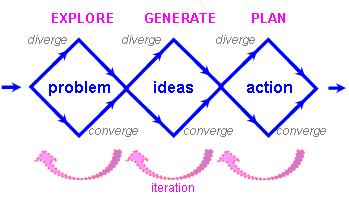The first post in this series (available here) gave a very quick, and probably superficial, introduction to what C-K Theory claims to be and to do. Now, we need to look at some established problem-solving methods to see how C-K Theory stands up.
Creative Problem-Solving :
CPS is well established. The method suggests that people separate their thinking into stages such as “problem exploration”, “idea generation and selection”, “action planning”. That sounds simple enough, until you try it with a group of colleagues. Some people want to jump straight to finding the solution. I call this the “Let’s get this problem out of here so we can let some more problems in” fallacy – that fastest is always best. Others feel energised by thinking up ever more creative solutions but lose the will to live when asked to turn just one of them into an action plan. The most difficult stage to “sell” is the idea of checking whether the problem as stated is really what the group should be tackling. A common objection is “This is what our boss wants us to solve so it must be right”.
If exploring the question isn’t challenging enough, CPS introduces the idea that, in each problem-solving stage, people should use both divergent thinking and convergent thinking – and to make sure that they do not mix them together.
Here is one way to picture the CPS approach:
 If you think about any meeting you have been in where the aim was to gather new ideas, you will probably recognise that a very common sequence is “someone proposes an idea; the others find all the bad points; so that won’t work;OK whos next?”. We call this “editing ideas as you go”. If this is your experience, you probably ended up with very few really novel ideas that withtood this kind of serial stress test.
If you think about any meeting you have been in where the aim was to gather new ideas, you will probably recognise that a very common sequence is “someone proposes an idea; the others find all the bad points; so that won’t work;OK whos next?”. We call this “editing ideas as you go”. If this is your experience, you probably ended up with very few really novel ideas that withtood this kind of serial stress test.
Even more worryingly, CPS has a lot of techniques based on metaphor (e.g. cartooning, word associations), challenging mindsets (e.g. reverse brainstorming, force-fitting), and playfulness (improvisation, poetry) . . . Enough! CPS sounds deeply uncomfortable.
But it works . . . when you are dealing with an intractable problem or you are genuinely looking for some breakthrough ideas . . . and when, most importantly, you work with a skilled CPS facilitator who can guide a group through the different CPS stages and divergent and convergent thinking by choosing the most appropriate technique at the right moment without adding their own ideas into the pot.
Behind CPS is the idea of creating permission, time and space for people to discover unusual re-combinations of concepts, images and thoughts which then pop out from the unconscious mind. Koestler called this process “bo-sociation”. These so-called “ah hah!” moments, rather than being fully-fledged solutions, are possibilities which open the door into unexpected “solution spaces”. Then the hard work of turning the idea into reality begins.
Coming soon –“C-K Theory, CPS and TRIZ #2 – What Are the Benchmarks? (part 2)